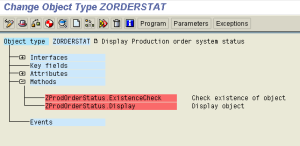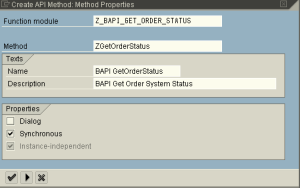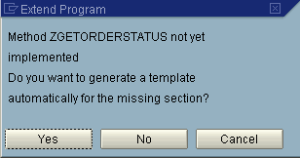About the example
This BAPI reads system status for a production order from table JEST and system status text from table TJ02T
Name | ZGetOrderStatus |
Function group | ZBAPISTATUS |
Function module: | Z_BAPI_GET_ORDER_STATUS |
Import parameters: | ORDER_STATUS_IMPORT type ZBAPI_ORDER_STATUS_IMPORT:
|
Tables | T_BAPISTAT type ZBAPISTAT:
|
Export parameters | RETURN like BAPIRETURN |
STEP 1 – Define a structures for the BAPI
In this step a structures for the parameters and tables of the function module used for the BAPI are defined.
Use Data type -> Structure
Define the following structures:
ZBAPI_ORDER_STATUS_IMPORT which contains the following fields:
ORDERID Order number (Keyfield)
SPRAS Language
ExcludeInactive – Checkbox – Exclude inactive status
ZBAPISTAT:
OBJNR like JEST-OBJNR
STAT like JEST-STAT
INACT like JEST-INACT
TXT04 like TJ02T-TXT04
TXT30 likeTJ02T-TXT30
Important note:
You will have to define a structure for every parameter in the BAPI. You cannot use the same structures used in existing applications because BAPI structures are frozen when BAPIs are released and then there are restrictions on changing them.
ZBAPI_ORDER_STATUS_IMPORT
ZBAPISTAT
STEP 2 – Write Function Module
Important notes:
Each BAPI must have its own function group.
Under the attributes tab remember to select Processing Type Remote Enabled module, otherwise the function module cannot be invoked via RFC and used as a BAPI
Import/Export parameters can only be BY VALUE for an RFC enabled function module
We are only creating one BAPI in this example, but you can create related BAPIs in the same function pool, so they will be able to share global data.
Attributes
Import Parameters
Export Parameters
Tables
Code
Notes:
The subroutine SET_RETURN_MESSAGE is a standard routine used for BAPIs that use the BAPIRETURN structure
In form Z_BAPI_GET_ORDER_SYSTEM_STATUS there is a test IF 1 = 2. If the test is true a message is displayed. The condition will obviously never be true, and we will never want to display a message in a BAPI. The reason why it is included is, that it create a reference for the message, so that the WHERE USED functionality can be used for the message. This is the SAP standard way to handle it, copied from the Company Code GetList BAPI.
INCLUDE LZBAPISTATUSUXX ***************************************************************** * THIS FILE IS GENERATED BY THE FUNCTION LIBRARY. * * NEVER CHANGE IT MANUALLY, PLEASE! * ***************************************************************** INCLUDE LZBAPISTATUSU02. "Z_BAPI_GET_ORDER_SYSTEM_STATUS INCLUDE LZBAPISTATUSTOP - Global data FUNCTION-POOL ZBAPISTATUS. "MESSAGE-ID Z3 Types: begin of Type_tj02t, istat like tj02t-istat, txt04 like tj02t-txt04, txt30 like tj02t-txt30, end of type_tj02t. DATA: * Declarations for TABLE parameter T_BAPISTAT like ZBAPISTAT occurs 0, G_BAPISTAT like ZBAPISTAT, * Table for object texts t_tj02t type type_tj02t occurs 0, g_tj02t type type_tj02t. * Structure for return messages DATA: BEGIN OF MESSAGE, MSGTY LIKE SY-MSGTY, MSGID LIKE SY-MSGID, MSGNO LIKE SY-MSGNO, MSGV1 LIKE SY-MSGV1, MSGV2 LIKE SY-MSGV2, MSGV3 LIKE SY-MSGV3, MSGV4 LIKE SY-MSGV4, END OF MESSAGE. INCLUDE LZBAPISTATUSF01 - Subroutines ***INCLUDE LZBAPISTATUSF01 . *----------------------------------------------------------------------* *&---------------------------------------------------------------------* *& Form SET_RETURN_MESSAGE *&---------------------------------------------------------------------* * This routine is used for setting the BAPI return message. * The routine is a standard routine for BAPIs that handles the message * structure for the BAPIRETURN structure. It has been copied from the * BAPI Company Code Getlist *----------------------------------------------------------------------* * -->P_MESSAGE text * <--P_RETURN text *----------------------------------------------------------------------* form SET_RETURN_MESSAGE USING VALUE(P_MESSAGE) LIKE MESSAGE CHANGING P_RETURN LIKE BAPIRETURN. CHECK NOT MESSAGE IS INITIAL. CALL FUNCTION 'BALW_BAPIRETURN_GET' EXPORTING TYPE = P_MESSAGE-MSGTY CL = P_MESSAGE-MSGID NUMBER = P_MESSAGE-MSGNO PAR1 = P_MESSAGE-MSGV1 PAR2 = P_MESSAGE-MSGV2 PAR3 = P_MESSAGE-MSGV3 PAR4 = P_MESSAGE-MSGV4 * LOG_NO = ' ' * LOG_MSG_NO = ' ' IMPORTING BAPIRETURN = P_RETURN EXCEPTIONS OTHERS = 1. endform. " SET_RETURN_MESSAGE FUNCTION Z_BAPI_GET_ORDER_STATUS FUNCTION z_bapi_get_order_system_status. *"---------------------------------------------------------------------- *"*"Local interface: *" IMPORTING *" VALUE(I_AUFNR) TYPE AUFNR *" VALUE(I_SPRAS) TYPE SPRAS DEFAULT SY-LANGU *" VALUE(I_EXCLUDEINACTIVE) TYPE CHAR1 OPTIONAL *" EXPORTING *" VALUE(RETURN) TYPE BAPIRETURN *" TABLES *" T_BAPISTAT STRUCTURE ZBAPISTAT *"---------------------------------------------------------------------- DATA: l_aufnr LIKE afko-aufnr, l_objnr LIKE jest-objnr. ******************************************** * Check if order exists ******************************************** SELECT SINGLE aufnr FROM afko INTO l_aufnr WHERE aufnr = BAPI_ORDER_STATUS_IMPORT-orderid. IF sy-subrc NE 0. CLEAR message. message-msgty = 'E'. message-msgid = 'Z3'. message-msgno = '000'. message-msgv1 = BAPI_ORDER_STATUS_IMPORT-orderid. PERFORM set_return_message USING message CHANGING return. IF 1 = 2. * The only reason to include this statement, that will obviously * never execute, is that it will create a referecence so that you * can find out where a particular message is being used. This * functionality is used by the BAPIs programmed by SAP MESSAGE e000(z3). ENDIF. ENDIF. CHECK return IS INITIAL. ******************************************** * Read order status ******************************************** CONCATENATE 'OR' BAPI_ORDER_STATUS_IMPORT-orderid INTO l_objnr. IF BAPI_ORDER_STATUS_IMPORT-i_excludeinactive = 'X'. SELECT objnr stat inact FROM jest INTO TABLE t_bapistat WHERE objnr = l_objnr AND inact <> 'X'. ELSE. SELECT objnr stat inact FROM jest INTO TABLE t_bapistat WHERE objnr = l_objnr. ENDIF. IF sy-subrc <> 0. * No object status found CLEAR message. message-msgty = 'E'. message-msgid = 'Z3'. message-msgno = '001'. message-msgv1 = BAPI_ORDER_STATUS_IMPORT-orderid. PERFORM set_return_message USING message CHANGING return. IF 1 = 2. MESSAGE e001(z3). ENDIF. ENDIF. CHECK return IS INITIAL. ******************************************** * Read order status texts ******************************************** SELECT istat txt04 txt30 FROM tj02t INTO TABLE t_tj02t FOR ALL ENTRIES IN t_bapistat WHERE istat = t_bapistat-stat AND spras = BAPI_ORDER_STATUS_IMPORT-i_spras. SORT t_tj02t BY istat. LOOP AT t_bapistat INTO g_bapistat. READ TABLE t_tj02t WITH KEY istat = g_bapistat-stat BINARY SEARCH INTO g_tj02t. IF sy-subrc = 0. MOVE: g_tj02t-txt04 TO g_bapistat-txt04, g_tj02t-txt30 TO g_bapistat-txt30. MODIFY t_bapistat FROM g_bapistat TRANSPORTING txt04 txt30. ENDIF. ENDLOOP. ENDFUNCTION.
STEP 3 – Create the API Method Using the BAPI WIZARD
The BAPI wizard is used toTo expose the remote function module as a BAPI. The wizard will generate some additional code, so the function module is a valid method of the BOR. This allows the BAPi to be called as a workflow method in addition to be called by an outside program.
Note: Each function module corresponds to a method in the BOR
Go to the Business Object Builder SWO1.
You can either create the new Object type as a subtype of an existing business object or create a new business object from scratch. In this example it would be obvious to create the Object type as a subtype of BUS2005 Production order. However, to illustrate how to create a new Object type from scratch, we will do this.
In the Object/Interface type field write the name of the new Business Object: ZORDERSTAT. Press enter and fill in the additional fields necessary to create the object type.
Supertype: Not relevant because we are creating our object from scratch
Program. This is the name of the program where the wizard generates code for the Object type, NOT the function module we created earlier. The program name must not be the name of an existing program.
Press enter and create the new business object. Note that when you create the business object a standard interface, an attribute ObjectType and the methods ExistenceCheck and Display are automatically generated. These cannot be changed !
The next step is to add the Z_BAPI_GET_ORDER_STATUS method to the business object. Select Utilities -> API methods -> Add method and write the name of the function module in the dialog box. Next the dialog ox show below will be shown. This is the start screen of the BAPI wizard. Proceed with wizard by pressing the ![]() button.
button.
After you have finished the wizard, you will notice that the ZGetOrderStatus has been added to the business object:
You can double-click on the method to see its properties. To use the business object you must change the Object type status to Implemented. Use menu Edit->Change releases status->Object type->To implemented. No you can test the object (Press F8).
Note that the BAPI wizard has added a wrapper class for the function module so it can be sued as method in the business object. Choose menu Goto->Program to display the program:
***** Implementation of object type ZORDERSTAT ***** INCLUDE <OBJECT>. BEGIN_DATA OBJECT. " Do not change.. DATA is generated * only private members may be inserted into structure private DATA: " begin of private, " to declare private attributes remove comments and " insert private attributes here ... " end of private, KEY LIKE SWOTOBJID-OBJKEY. END_DATA OBJECT. " Do not change.. DATA is generated BEGIN_METHOD ZGETORDERSTATUS CHANGING CONTAINER. DATA: BAPIORDERSTATUSIMPORT LIKE ZBAPI_ORDER_STATUS_IMPORT, RETURN LIKE BAPIRETURN, TBAPISTAT LIKE ZBAPISTAT OCCURS 0. SWC_GET_ELEMENT CONTAINER 'BapiOrderStatusImport' BAPIORDERSTATUSIMPORT. SWC_GET_TABLE CONTAINER 'TBapistat' TBAPISTAT. CALL FUNCTION 'Z_BAPI_GET_ORDER_STATUS' EXPORTING BAPI_ORDER_STATUS_IMPORT = BAPIORDERSTATUSIMPORT IMPORTING RETURN = RETURN TABLES T_BAPISTAT = TBAPISTAT EXCEPTIONS OTHERS = 01. CASE SY-SUBRC. WHEN 0. " OK WHEN OTHERS. " to be implemented ENDCASE. SWC_SET_ELEMENT CONTAINER 'Return' RETURN. SWC_SET_TABLE CONTAINER 'TBapistat' TBAPISTAT. END_METHOD.
STEP 4 – Final steps
When the Business object has been checked and the documentation created, the following steps must be carried out:
Release the BAPI function module (in the Function Builder).
Release the business object type (in the BOR Object Type -> Change release status to -> Implemented ).
Release the BAPI as a method in the BOR (Release the methods you has created – Set the cursor on the method then
Edit -> Change release status -> Object type component -> To released )
For potential write BAPIs: Release the IDoc and its segments
You can now display the BAPI in the BAPI Explorer:



















